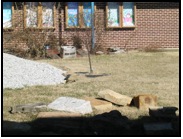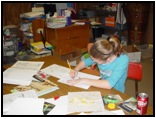 I was thrilled to receive a GreenWorks! grant from Project Learning Tree to help create a schoolyard habitat, part of an outdoor classroom at Valley Springs Elementary School in Arkansas. My third and fourth grade gifted and talented students designed and developed the project to provide food, water, cover and nesting areas to attract wildlife to their school grounds.
I was thrilled to receive a GreenWorks! grant from Project Learning Tree to help create a schoolyard habitat, part of an outdoor classroom at Valley Springs Elementary School in Arkansas. My third and fourth grade gifted and talented students designed and developed the project to provide food, water, cover and nesting areas to attract wildlife to their school grounds.
The professional development I obtained from state resources was invaluable and guided me in the right direction. I attended several workshops, and each time I came away with valuable ideas from both trainers and other teacher participants. I have received curriculum manuals from the Arkansas Game and Fish Commission (AGFC), Project Learning Tree, and Projects WET/WILD, along with training on how to incorporate them in our outdoor classroom. The manuals are full of engaging activities that my students really enjoy.
As I reflect on the journey that we have taken together to create this schoolyard habitat, there are things I learned along the way that may be useful to other schools wanting to undertake a similar project.
Research Similar Projects
 If possible, visit a schoolyard habitat site or another project that’s similar to what you’ll undertake. Depending on the size and complexity of your project, it is important to have firsthand knowledge wherever possible.
If possible, visit a schoolyard habitat site or another project that’s similar to what you’ll undertake. Depending on the size and complexity of your project, it is important to have firsthand knowledge wherever possible.
I was not aware of a schoolyard project in my area so I visited the nearby Fred Berry Conservation Center. I made notes about what I saw planted around their facilities and where they placed identification markers.
Planning and Prioritizing is Critical
The most challenging part of the project for us was getting so many funds and donations all at once. We received four of the five grants we applied for, which allowed us to add a greenhouse with a garden area, a water feature, and a bird blind to our schoolyard habitat. In addition, we received donations of materials, labor, and equipment for a retainer wall next to the greenhouse.
As the project coordinator, I had to prioritize installations according to how much space a backhoe and tractor would need to move in our compacted area and avoid damage to the trees we had planted. Waiting on other construction projects to be completed drastically altered our original schedule.
Form a Committee
 I formed a committee of teachers, students, school administrators, parents, and community partner volunteers to help implement this project. It truly was a community-wide effort.
I formed a committee of teachers, students, school administrators, parents, and community partner volunteers to help implement this project. It truly was a community-wide effort.
Community partners helped with the heavy work that our elementary children could not do, such as lifting and setting boulders in place and carving wooden animals.
The school’s maintenance staff helped with utility layout, and provided a tractor and dolly to help move the boulders.
One parent, Dawn Mathis, worked hard to promote what we are doing. She set the date for our dedication event with the school administration and coordinated the catering of food and beverages.
So that everything runs smoothly, we schedule a volunteer work day a week before the dedication event.
Enlist the Help of Community Volunteers
So far, we’ve had over 30 community members help us with our schoolyard habitat project. Ten volunteers helped plan the mini forest, guided students during tree planting, and made sure students helped water the young trees regularly. Several volunteers donated boulders and rocks to create a bluff-like structure for a simulated bear habitat, while others provided logs and branches to create a mock beaver dam.
Get Guidance from Professionals
Don’t be afraid to ask for guidance from professionals who might be able to offer assistance. Getting the opinions and guidance from professionals has helped put our project on the path to success.
For example, we enlisted the help of a local landscape designer, Starlinda Saunders, to create a professional set of plans for us to use during the grant writing process. These have been very useful for inventory purposes, in our public relations efforts, and for future planning.
Another example: I had planned on installing a solar pump for our water feature, but later learned that its capacity was not big enough for the size of our pond and it would have only produced a trickle for a waterfall. Knowing this ahead of time helped us alter our budget accordingly and purchase the right equipment.
If you need help selecting native plantings in your area, seek out assistance from your state organizations. I spoke often with personnel from our local forestry agencies and the Arkansas Game and Fish Commission.
Involve Students in all Aspects
To date, 36 elementary gifted students have participated in designing and developing their schoolyard habitat in a vacant area measuring 64’ x 95’. They divided up the area to incorporate multiple components.
One student, Mercedes Youngblood, started the plans for our mini woodland forest when she was a third grader and has since been very active in the project. She and her fellow students helped plan where to plant the trees and place the carved wooden animals. Last year, they planted five trees and watered them during the summer. This year, as soon as the ground thawed, they planted five more. Mercedes is now a fifth grader and she is working with several other students on a woodland forest mural that will be unveiled during our dedication ceremony.
Publicize Your Project
Publicizing the project isn’t just about sharing your story, it’s also a great opportunity for the students to develop their leadership and public speaking skills.
We’ve had several opportunities to publicize our project, and the students were an integral part of sharing our story:
- A local journalist wrote a story about our schoolyard habitat. Students answered questions about the different components they were working on.
- Our local newspaper is sending a reporter to our “Learning on Parade” night. In addition to preparing for interviews from those journalists, they wrote letters to Members of Congress to invite them to the event. The goal is for them to to see first-hand the benefits of outdoor and environmental education.
- Students are preparing to present their project to the Kiwanis Club members to share their story.
Be Prepared for the Unexpected
Our dedication event for the schoolyard habitat project happened a full year later than expected. Illness, flooding, and a snow/ice storm that cut off almost all electricity this year were things I hadn’t anticipated. We rarely miss school due to inclement weather, so I never expected to be out of school so long. The important lesson here is to be patient and keep the project moving forward despite any obstacles you might encounter!
Use PLT’s GreenWorks! Guide
Use Project Learning Tree’s GreenWorks! guide throughout your project. It’s a great tool to help your team organize your project.
Good luck and, most of all, have fun!!


